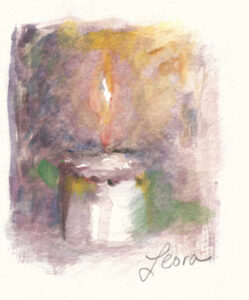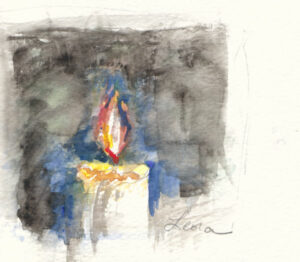I needed to send someone a condolence card. Someone who sat shiva (one sits shiva for seven days for a close relative, in this case a brother) far away. So I painted two watercolors of yahrzeit candles. I’ve never painted lit candles before, and it wasn’t easy. I chose one to send. Here are both the watercolors:



Another Photoshopped photo. I do hope these women don’t recognize themselves. I used so many different Photoshop tools: brush, clone stamp, palette knife, colored pencil filter, sponge, desaturate, paint daubs, magic wand.

Spider plant outside window of my friends’ home in Hashmonaim, ink pen on paper, tweaked with some color in Photoshop

Same spider plant drawing, ink pen on paper, before any color additions

Welcome to the modern world. If you can play with a painting in Photoshop, why not? I applied the palette knife filter to my gouache painting (that painting did have a bit of watercolor in the background, too, by the way). I then un-applied the filter to the spot that had my signature.

Goache on paper, 2008
Can anyone tell me how one can be in three places at once? This past Sunday there was a wonderful art show in Highland Park, which I missed because I was here and then at the tail end of the Cong. Etz Ahaim picnic.
Bill Bonner, an talented, artistic photographer and one of the exhibitors in the show sent me these photos that he took of the reception last Sunday:



Other artists in the show included my friend Jill Caporlingua, who has written posts on this blog and sometimes comments, my neighbor Mort Farrah, and my friend Rick Black. Sharon Sayegh, a painter I admire, also exhibited.
 For more Highland Park artists, see http://www.highlandparkartists.org
For more Highland Park artists, see http://www.highlandparkartists.org

Do like salads? Do you like elegant salads? Do you like the idea of being able to go to your backyard (or a container for plants, if you don’t have a backyard) and pick a pretty flower and round, green, tangy leaves to put in your salad?
In order to present to you nasturtium, the flower pictured in this watercolor, I wanted to show you a picture of this edible plant. Instead of showing a photograph, I decided to do a watercolor. When you paint, unlike in a photograph, you can choose what you want to present. So I decided to emphasize the flowers (which will become pretty petals of orange, yellow or red in your salad) and the round-shaped leaves.
The nasturtium seed looks like a shriveled chickpea. It grows easily: all you need to do is poke it with your finger into the ground. Don’t plant nasturtium where you have precious grass; the nasturtium plant will take over, and come frost time you’ll have a bare spot where you used to have grass. But I find it fairly easy to grow. The first summer I tried there was a drought in New Jersey, and these plants did not do well. But recently we’ve had a lot of rain, and my little germinated nasturtium plants are already sticking two round little leaves out of the ground.
More about nasturtium here.

This artwork of Ruth and Boaz is by Julius Schnorr von Carolsfeld, a German painter who lived from 1794-1872. It seems to be a study for an oil painting of Ruth in the Fields of Boaz.
This post is an introduction to a series of posts by Ilana-Davita and me on Ruth and the holiday of Shavuot. Read an introduction to Shavuot by Ilana-Davita.
And now, about public domain art: When is it OK to put up someone else’s art? When is it stealing?
Works of art that are from the 19th Century or earlier are, generally speaking, in the public domain. But your best bet is to go to a site like Wikimedia, and take art that declares that it is in the public domain or under a license that allows you to use it. For more recent images, you can use artwork or photos that are under a license such as GNU Free Documentation License.
There is also a concept called fair use. Fair use means you can use it for educational purposes but not for commercial purposes. So you could argue that you could use one of my paintings if you were trying to teach something.
But I got a better idea. If you want to use something that belongs to someone else, ask. It’s just common courtesy. And give credit back to the person to whom it belongs.
This is very simplified; if you want to study copyright law, you could come up with a much more complicated discussion on images and use on the web.
More about public domain art and reproductions here.

My newest watercolor.
I could have called this post “Mother of Jewish Boys” or “Mother of My Boys.” I still don’t have a name for the actual painting. I was thinking of putting a softball in this still-life, but neither of my boys play baseball anymore.
For those that would like some explanation, the four-cornered garment that Jewish boys and men wear is called tzitzit, as it says in Numbers 15:38, Parshat Sh’lach:
Speak unto the children of Israel, and bid them that they make them throughout their generations fringes in the corners of their garments
The blue book in the right corner is a prayer book, a siddur. That siddur happens to be the one many boys, including my boys, use in elementary school.
My daughter’s kindergarten class is doing a section on artists. So far, they have learned about Seurat, Jackson Pollack, Monet and Matisse. And they met the illustrator of Only Nine Chairs: A Tall Tale for Passover, who happens to be the grandmother of one of the kindergarten students.
Today, they met an artist who likes to do Jewish subjects: me.
First, I showed them my havdalah painting:

I asked them what they saw. They mentioned the candle, the cup, the plate. Then I asked them about the colors. What colors did they see on the cup? What colors do you see? Any idea why I put red next to green? I told them I was inspired by Rembrandt. Their teacher then pulled out the Night Watch (that’s not its real name, just its popular name), and I pointed out how the light and the angles of Rembrandt’s painting had similarities with mine.
Next I presented the four cups:

We talked about pointillism, and how the colors in this one differed from the previous painting. Besides the cups, what else is 4 in the hagaddah? The kids reminded me that there are four questions. But what I had in mind was the four sons. Why is one son separate from the others? They believed it was the “rasha”, the bad son. That wasn’t what I had in mind when I did the painting, but I let my viewers find their own interpretations.
They loved my final painting, a watercolor:

Not only is it someone they know well (my daughter), but the setting is their classroom.











 For more Highland Park artists, see
For more Highland Park artists, see 




